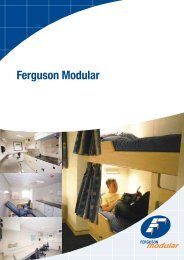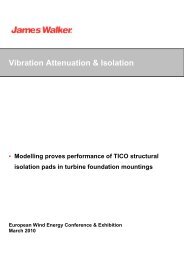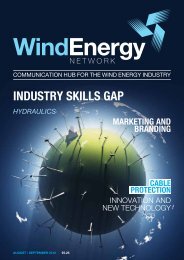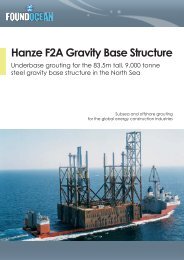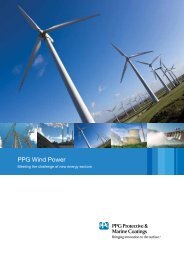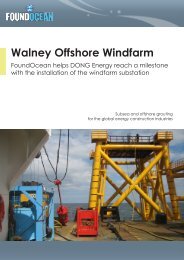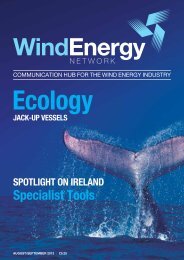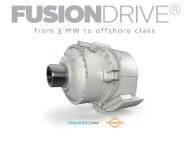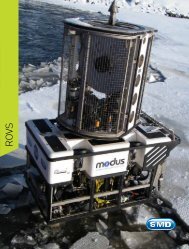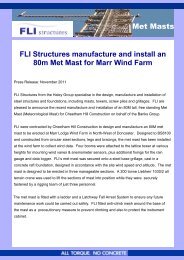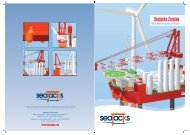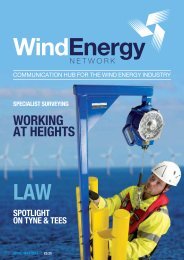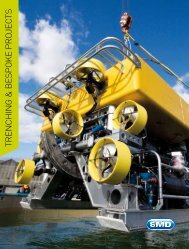JUNE/JULY 2013 | £5.25 - Wind Energy Network
JUNE/JULY 2013 | £5.25 - Wind Energy Network
JUNE/JULY 2013 | £5.25 - Wind Energy Network
You also want an ePaper? Increase the reach of your titles
YUMPU automatically turns print PDFs into web optimized ePapers that Google loves.
scour featurescour featureIdentifyingscour riskScour is a significant concernfor offshore wind developers andoperators, and considerable effort isdedicated to scour prevention andmonitoring activity. If scour develops, ithas the ability to dramatically weakenstructural stability, particularly for thecommon monopile foundation.It is therefore critical to identify thepotential for scour risk so that adequateprotection can be designed andimplemented. Scour is also problematicfor buried cables, and as cables accountfor another major cost it is equallyimportant to understand the nature of theseabed along the export cable routes.Prevention of scour throughoutthe life-cycleOsiris Projects play a role in the preventionof scour throughout the life-cycle. Preconstruction,this involves acquiring dataon the nature of the site, paying particularattention to characteristics associated withthe presence and extent of scour.They gather data on the nature of theseabed and water-column using a rangeof survey and oceanographic sensors,which is then evaluated by scourassessment specialists.Data analysedAspects such as the nature and mobilityof shallow sediments, sand waves, megaripples and wave and current oceanographicdata will be of particular interest. For sitesunderlain by marine clay, scour is rarelya serious issue, but for developmentssituated on unconstrained depths of sandysediments, scour clearly presents a severehazard.Effective techniquesThere are numerous innovative andeffective techniques employed specificallyfor the monitoring of scour, which supportyearly or twice-yearly detailed monitoringsurveys as stipulated by consenting andlicensing agreements.Operators must also plan for major stormevents, which can drastically adjust theseabed morphology. Osiris Projectsregularly performs post-constructionmonitoring surveys, typically acquiringhigh-resolution bathymetry which is thencombined with previous datasets toassess seabed movement.Volume analysisThe volume analysis technique is relativelysimple; overlaying new and previouslyacquired bathymetry shows the net changeto the shape of the seabed. This methodallows you to literally see the movement ofsandwaves between surveys, so not onlycan you monitor the extent of sedimentmovement around structures, but it is alsopossible to estimate the rate of change anduse this to predict the lifespan of any scourprotection in place.Cable depth monitoringFor cable depth of burial monitoring, theprocess is not so simple and there arevarious inherent challenges. The primaryrestriction is that the industry standardmethod of tracking the horizontal andvertical position of the cable is greatly limitedby range. This means the sensor must bepositioned close to the seabed and cannotbe towed from a vessel, it must be mobilisedto an ROV. Whether this is a traditionalfree-flying ROV or tracked crawler systemis irrelevant; the costs increase dramaticallywhen ROVs are involved.Significant cost and concernConsidering the volume of in-service andplanned subsea cables associated withoffshore wind, this is a significant cost.Another issue with mobilising ROVs to site isthe class of vessel required to accommodatethe ROV and personnel. Tracking a cablefrom substation to landfall using a vesselbased ROV method is problematic, as thesize of vessel required limits the ability totrack the cable in shallow water.Another concern is that not allenvironments are suitable for ROVs,particularly in shallow areas, and closeproximity to the seabed cannot alwaysbe achieved. For tracked systems, thisbecomes less of an issue as the route isengineered to accommodate the trenchingand jetting burial systems.Tracked inspection ROVOsiris Projects invested in a trackedinspection ROV in 2012 specifically toperform cable depth of burial surveys,and are currently considering designingour own bespoke crawler with enhancedcapability. Advances in cable trackingtechnology will undoubtedly bring towedoptions, but until then tracked ROVs offera suitable solution.GPS and DP technologySecondly, GPS and DP technology hassignificantly improved since the first offshorewind cables were installed, so the olderthe cable, the greater allowance shouldbe made for positional inaccuracy. Whileongoing and recent monitoring surveys giveaccurate positional information, conclusionsmade on the movement of the cable/seabedsince installation can never be made with100% confidence.SummaryIn summary, scour can be exceptionallyhazardous, and surveys are commissioned tocontractors such as ourselves to understandthe nature of the seabed and the potentialscour risk, while monitoring surveys givesnapshots which over time provide detailedinformation on the development of scour.Osiris Projectswww.osirisprojects.co.ukClick to view more info= Click to view video 1= Click to view video 2Remote Monitoring SystemsSupport Scour PreventionIn collaboration with University ofSouthampton, Kongsberg Maritime’ssubsea experts in the UK and sonarspecialists in Canada have designedan innovative solution to remotelymonitor the development of scour atthe base of offshore wind turbines.Offshore Scour MonitoringSystemThe Offshore Scour Monitoring System, inthe context of marine renewables provideslong term monitoring of the seabed in theimmediate vicinity of turbine foundations.Dual Axis Scanning SonarUsing the Dual Axis Scanning Sonar(DAS) to continuously monitor the seabedaround the turbine, the system logs allthe data and transmits this data to shorevia the telemetry infrastructure, cabled orwireless, installed in the turbine.“The system can accurately visualisethe scouring at the base of the turbine,showing engineers to what level thesupporting capability of the seabed isBi-Flex concrete mattressesWhere cohesionless soils makes upthe seabed this material can be subjectto scour caused by changes in waterparticle velocity.For offshore wind farm structures scouris caused by the installation of piles, hubstructures and any objects placed on theseabed that alter the water velocity.VulnerabilityLarge diameter objects are vulnerable tosignificant scour and thus it is large monopilesthat need consideration for scour prevention.Although clay soils do not scour, where thereis a thin veneer there is a possibility of thematerial being removed by abrasion leavingunderlying sand subject to scour.Proven systemConcrete flexible mattresses are nowa proven system of scour prevention.Mattresses are designed to be self-stableand prevent the underlying soil erodingand by being flexible any initiation of scouraround the mattress edges allows the edgeblocks to fall into the scour depression andhalts any further erosion.lost. Sometimes the pit is several metresdeep and can drastically alter the supportand vibration characteristics of the turbineso it’s vital that a clear view of whatis happening on the seabed is readilyavailable,” explains Peter Ward, UnderwaterAcoustics and Marine Impacts Specialist atKongsberg Maritime in the UK.Continuous monitoringThe continuous monitoring capability ofthe system provides valuable informationregarding the dynamics of scour formationand sediment backfill. When the tidal flowdirection changes, the scoured out sedimentmay refill the pit, but being unconsolidated, itwill have little or no load bearing capability.This information, which is not availablefor the less frequent multibeam scoursurveys, provides the opportunity for quickremedial action before the scour becomescritical to the monitored structure.Paying dividendsThis is where hydro acoustic monitoringreally pays dividends according to Ward:Proactive methodA more proactive method of scour preventionis to incorporate fronds onto the concretemattresses. They are laid with the frondskept under a safe net until the total array hasbeen installed and then the nets are releasedto allow the fronds to form a covering of this‘artificial seaweed.’ Fronds work by reducingthe velocity of the water locally and in doingso those particles that cannot be held insuspension drop down. The viscous dragcreated by the buoyant fronds causes thisreduction in current velocity.Over a period of time, and this can be withina matter of days or a few weeks, a sediment“Our system not only monitors the depthof the seabed around each wind turbine,which is important information in itself,but also provides insight regarding thedynamic changes of the underlyingseabed structure. This translates intolower intervention costs for maintainingthe structure within the design parametersand avoids reductions in the life span ofthe wind turbine associated with unstablefoundations and vibration inducedstructural fatigue.”Kongsberg Maritimewww.km.kongsberg.comembankment builds up to a height of up to1.1m. Thus not only is scour prevented buta reinforcing embankment is formed.Cable protectionThe same approach can be used forprotection of the cables, a line of frondedmattresses can be laid where burial is notviable, and thus permits an embankment tobe formed giving both stability and impactprotection.Pipeshield has been involved in manyoffshore oil and gas projects for scourprevention and the following offshore windfarm projects…• Lincs OWF• Gwynt-y-Mor• Egmond <strong>Wind</strong> Park• Dan Tysk• Scroby Sands• Lynn Inner Dowsing• ThannetPipeshieldwww.pipeshield.comClick to view more info52 www.windenergynetwork.co.ukwww.windenergynetwork.co.uk 53



